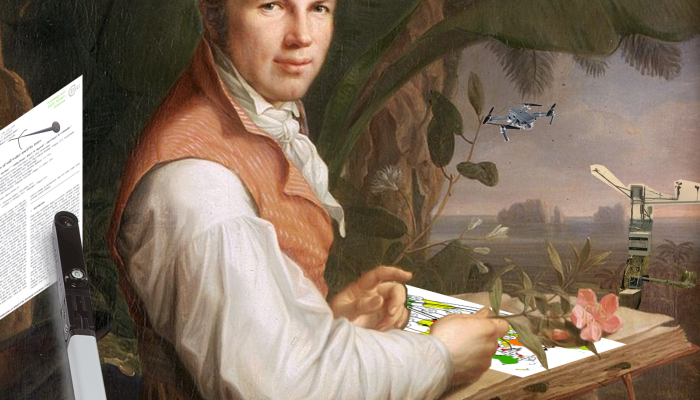
The first time I came across Alexander von Humboldt I was a freshman at the University of Bayreuth. We were proudly told that we were studying environmental science in a region where Humboldt used to work in, prior to his adventures in the Americas. Within EGU, von Humboldt is well known, in connection with the Union medal for “scientists who have performed research in developing regions for the benefit of people and society”, which is awarded in his memory. To celebrate Humboldt’s 250th birthday this year, I share how reading about him has encouraged my research.
Global networks –possible and critical

Example of an early map of the magnetic field using isodynamics lines. https://commons.wikimedia.org/wiki/File:FMIB_43939_Isodynamic_Lines.jpeg
Humboldt was extremely well connected with other scientists. He used his network to push for measurement networks of the Earth’s magnetic field and climate. While scientists in the 21st century are more connected than ever, we still benefit enormously from global measurement initiatives such as the Global Network of Isotopes in Precipitation (GNIP) or the FluxNET network to measure ecosystem carbon, water, and energy fluxes. Similar to von Humboldt’s initiatives, which allowed to map the spatial variability of both the magnetism using isodynamic lines (Fig. 1) and air temperature using isotherms, GNIP enables deriving the geographical patterns in the isotopic compositions of precipitation and FluxNET exposes global variability of evapotranspiration. I believe that such global networks provide invaluable insights on linkages between hydrology, climatology, and biogeochemistry and that these approaches shape our understanding of the most pressing water issues.
Von Humboldt got frustrated when his explorations were sometimes stopped or delayed by political developments (e.g. Napoleonic wars, British colonialism). Similarly, I get upset by political decisions that are counterproductive for scientific networks, such as changing Visa requirements and Brexit. Nevertheless, I have the impression that global scientific networks are doing well and that – very much in the light of von Humboldt’s support of junior researchers – early career scientists often get great support from established researchers.
All is interaction? – connecting human and ecological dimensions

How would Alexander von Humboldt do research today? Maybe he would do various measurements using the latest technical developments from remote sensing, field observations and tracer data? (Original photo from: https://en.wikipedia.org/wiki/Alexander_von_Humboldt#/media/File:Alexandre_humboldt.jpg)
Humboldt is seen as a “nomad of science, a traveler who connected the most diverse regions and cultures as well as the most different sciences”. During von Humboldt’s time, his “conceptual unification among the sciences of the Earth” was relatively exceptional in an era of disciplinary specialization. He realized on his exploration in the Americas that “Alles ist Wechselwirkung” (he wrote in 1803 in his otherwise French diary; Engl. “All is interaction and reciprocal”), which seems for most of us nowadays probably as a truism. But, do we account for it in our research? I think that emerging ideas in ecohydrology and concepts such as catchment co-evolution and the critical zone are critical for transdisciplinary research, and some even say that Humboldt “foreshadowed” critical zone science.
Recent commentaries in hydrology outline how Socio-hydrology is “a new science of people and water” and the International Association of Hydrological Sciences dedicated the current scientific decade (2013–2022) to research activities on change in hydrology and society to foster this field of science. These initiatives have a lot in common with Humboldt’s views. Linkages between past and present are very explicit in his Personal Narrative, written about 200 years ago, in which he reflects upon the conflict between economic progress and ecohydrological degradation: “By felling the trees, that cover the tops and the sides of mountains, men in every climate prepare at once two calamities for future generations; the want of fuel and a scarcity of water.”
Humboldt acknowledged problems that transcend generations and his awareness of environmental justice were new to his time. Today, we are concerned about “hydrological justice” (just 105 results on Google search), when we think for example of the inequality with regard to access to clean water, pollution of rivers, and hydrometeorological impacts of climate change. Hydrologists help describing these problems and providing suggestions to solve them. In this context, reading about von Humboldt inspires me to do Humboldtian Science which “could be described as the construction of a network between the different sciences and the different scientists”.
